|
List of birds of Alberta
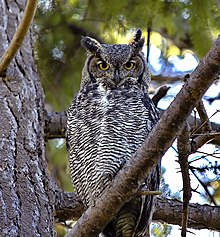 Alberta is a landlocked province within Canada, bordered by British Columbia to the west, Saskatchewan to the east, the North-West Territories to the north, and the U.S. state of Montana to the south.[1] The northern part of the province is largely boreal forest, leading into the Great Plains in the south-east. The south-west portion of the province is generally temperate coniferous forest, bordered by the Rocky Mountains.[2] These different ecosystems, along with the border formed by the Rocky Mountains, contribute to the diversity of birds in the province. Notably, several "eastern" and "western" pairs can be seen in Alberta, such as the eastern bluebird and western bluebird.[3] The Central Flyway passes through Alberta, along with a portion of the Prairie Pothole Region, contributing to the variety of bird species which breed in, or migrate through, the province.[4][5] Unless otherwise noted, the information provided is from the Official List of the Birds of Alberta, produced by the Alberta Bird Record Committee, which contains 438 species as of April 2023.[6] Of these, 125 are accidentals, eight were introduced to Alberta, one species is extinct, and another is possibly extinct. This list is presented in the taxonomic sequence of the Check-list of North and Middle American Birds, 7th edition through the 62nd Supplement, published by the American Ornithological Society (AOS).[7] Common and scientific names are also those of the Check-list, except that Canadian English spellings are used and the common names of families are from the Clements taxonomy because the AOS list does not include them. The following tags are used to describe some categories of occurrence.
Ducks, geese, and waterfowlOrder: Anseriformes Family: Anatidae   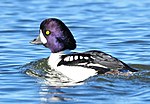 Anatidae includes the ducks and most duck-like waterfowl, such as geese and swans. These birds are adapted to an aquatic existence with webbed feet, bills which are flattened to a greater or lesser extent, and feathers that are excellent at shedding water.[8]: 13–17
Pheasants, grouse, and alliesOrder: Galliformes Family: Phasianidae 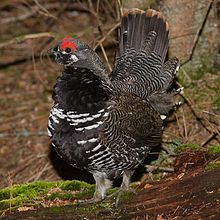 Phasianidae consists of the pheasants and their allies. These are terrestrial species, variable in size but generally plump with broad relatively short wings.[8]: 24–27 Many species are gamebirds or have been domesticated as a food source for humans.[9]
GrebesOrder: Podicipediformes Family: Podicipedidae  Grebes are small to medium-large freshwater diving birds. They have lobed toes and are excellent swimmers and divers. However, they have their feet placed far back on the body, making them quite ungainly on land.[8]: 30
Pigeons and dovesOrder: Columbiformes Family: Columbidae Pigeons and doves are stout-bodied birds with short necks and short slender bills with a fleshy cere. They have strong flight muscles, allowing them to take off almost vertically and fly for long distances.[8]: 32
CuckoosOrder: Cuculiformes Family: Cuculidae 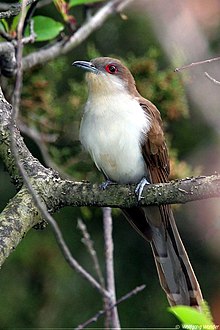 The family Cuculidae includes cuckoos, roadrunners, and anis. These birds are of variable size with slender bodies, long tails, and strong legs.[8]: 57–58
Nightjars and alliesOrder: Caprimulgiformes Family: Caprimulgidae Nightjars are medium-sized nocturnal birds that usually nest on the ground. They have long wings, short legs, and very short bills. Most have small feet, of little use for walking, and long pointed wings. Their soft plumage is cryptically coloured to resemble bark or leaves.[8]: 40
SwiftsOrder: Apodiformes Family: Apodidae Swifts are small birds which spend the majority of their lives flying. These birds have very short legs and never settle voluntarily on the ground, perching instead only on vertical surfaces. Many swifts have long swept-back wings which resemble a crescent or boomerang.[8]: 48
HummingbirdsOrder: Apodiformes Family: Trochilidae  Hummingbirds are small birds capable of hovering in mid-air due to the rapid flapping of their wings. They are the only birds that can fly backwards.[8]: 52
Rails, gallinules, and cootsOrder: Gruiformes Family: Rallidae  Rallidae is a large family of small to medium-sized birds which includes the rails, crakes, coots, and gallinules. Many species occupy dense vegetation in damp environments near lakes, swamps, or rivers. In general they are shy and secretive birds, making them difficult to observe. Most species have strong legs and long toes which are well adapted to soft uneven surfaces. They tend to have short, rounded wings and to be weak fliers.[8]: 61–63
CranesOrder: Gruiformes Family: Gruidae  Cranes are large, long-legged birds who fly with their distinctive long necks outstretched. Most have elaborate and noisy courting displays or "dances". The breeding grounds for the only wild population of whooping cranes is in Wood Buffalo National Park in northern Alberta.[8]: 67–69
Stilts and avocetsOrder: Charadriiformes Family: Recurvirostridae Recurvirostridae is a family of large wading birds which includes the avocets and stilts. The avocets have long legs and long up-curved bills. The stilts have extremely long legs and long, thin, straight bills.[8]: 110
Plovers and lapwingsOrder: Charadriiformes Family: Charadriidae  The family Charadriidae includes plovers, dotterels, and lapwings. They are small to medium-sized birds with compact bodies, short thick necks, and long, usually pointed, wings. They are found in open country worldwide, mostly in habitats near water.[8]: 105
Sandpipers and alliesOrder: Charadriiformes Family: Scolopacidae 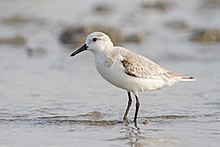  Scolopacidae is a large diverse family of small to medium-sized shorebirds including the sandpipers, curlews, godwits, shanks, tattlers, woodcocks, snipes, dowitchers, and phalaropes. The majority of these species eat small invertebrates picked out of the mud or soil. Different lengths of legs and bills enable multiple species to feed in the same habitat, particularly on the coast, without direct competition for food.[8]: 116–117
Skuas and jaegersOrder: Charadriiformes Family: Stercorariidae  Skuas and jaegers are medium to large seabirds with strongly hooked talons, hooked beaks, and webbed feet. They are pelagic birds and feed on a variety of animals—such as fish, bird eggs, and lemmings—by hunting, scavenging, or kleptoparasitizing them.[15][16][17]
Auks, murres, and puffinsOrder: Charadriiformes Family: Alcidae Alcids are superficially similar to penguins due to their black-and-white colours, their upright posture, and some of their habits, however they are only distantly related to the penguins and are able to fly. Auks live on the open sea, only deliberately coming ashore to nest.[8]: 123–125
Gulls, terns, and skimmersOrder: Charadriiformes Family: Laridae 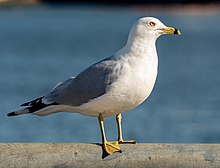  Laridae is a family of seabirds consisting of gulls, terns, and skimmers. Gulls are typically grey or white, often with black markings on the head or wings. Terns are generally smaller than gulls with more pointed wings and bills, many also having forked tails which help with aerial manoeuvrability. Both species can be found inland near lakes and rivers, however gulls have adapted well to human presence and can often be found in urban centers.[8]: 127–129 Skimmers have not been recorded in Alberta.[6]
Loons Order: Gaviiformes Family: Gaviidae Loons are aquatic birds, the size of a large duck, to which they are unrelated. Their plumage is largely grey or black, and they have spear-shaped bills. Loons swim well and fly adequately, but are almost hopeless on land, because their legs are placed towards the rear of the body.[8]: 73–74
Cormorants and shagsOrder: Suliformes Family: Phalacrocoracidae Cormorants are medium-to-large aquatic birds, usually with mainly dark plumage and areas of coloured skin on the face. The bill is long, thin, and sharply hooked. Their feet are four-toed and webbed.[8]: 102–103
PelicansOrder: Pelecaniformes Family: Pelecanidae 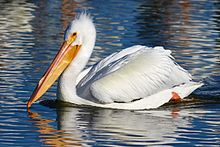 Pelicans are very large water birds with a distinctive pouch under their beak.[8]: 91 Like other birds in the order Pelecaniformes, they have four webbed toes.[8]: 88
Herons, egrets, and bitternsOrder: Pelecaniformes Family: Ardeidae  The family Ardeidae contains the herons, egrets, and bitterns. Herons and egrets are medium to large wading birds with long necks and legs. Bitterns tend to be shorter necked and more secretive. Members of Ardeidae fly with their necks retracted, unlike other long-necked birds such as storks, ibises, and spoonbills.[8]: 94–97
Ibises and spoonbillsOrder: Pelecaniformes Family: Threskiornithidae 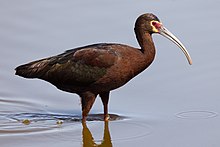 The family Threskiornithidae includes the ibises and spoonbills. They have long, broad wings. Their bodies tend to be elongated, the neck more so, with rather long legs. The bill is also long, decurved in the case of the ibises, straight and distinctively flattened in the spoonbills.[8]: 97–98
New World vulturesOrder: Accipitriformes Family: Cathartidae The New World vultures are not closely related to Old World vultures, but superficially resemble them because of convergent evolution. Like the Old World vultures, they are scavengers. However, unlike Old World vultures, which find carcasses by sight, New World vultures have a good sense of smell with which they locate carcasses.[8]: 131–133
OspreyOrder: Accipitriformes Family: Pandionidae  Pandionidae is a family of fish-eating birds of prey possessing a very large, powerful hooked beak for tearing flesh from their prey, strong legs, powerful talons, and keen eyesight. The family is monotypic.[8]: 135
Hawks, eagles, and kitesOrder: Accipitriformes Family: Accipitridae  Accipitridae is a family of birds of prey which includes hawks, eagles, kites, harriers, and Old World vultures. These birds have very large powerful hooked beaks for tearing flesh from their prey, strong legs, powerful talons, and keen eyesight.[8]: 136–137
Barn-owlsOrder: Strigiformes Family: Tytonidae Owls in the family Tytonidae are medium to large owls with large heads and characteristic heart-shaped faces.[8]: 141–142
OwlsOrder: Strigiformes Family: Strigidae 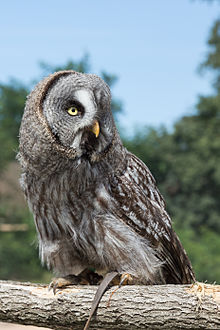 Typical owls are small to large solitary nocturnal birds of prey. They have large forward-facing eyes and ears, a hawk-like beak, and a conspicuous circle of feathers around each eye called a facial disk.[8]: 143–145
KingfishersOrder: Coraciiformes Family: Alcedinidae Kingfishers are medium-sized birds with large heads, long, pointed bills, short legs, and stubby tails.[8]: 180–181
WoodpeckersOrder: Piciformes Family: Picidae 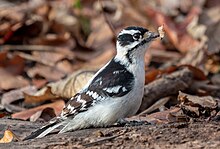  Woodpeckers are small to medium-sized birds with chisel-like beaks, short legs, stiff tails, and long tongues used for capturing insects. Some species have feet with two toes pointing forward and two backward, while several species have only three toes. Many woodpeckers have the habit of tapping noisily on tree trunks with their beaks.[8]: 164–165
Falcons and caracarasOrder: Falconiformes Family: Falconidae 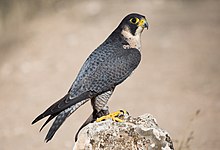 Falconidae is a family of diurnal birds of prey, notably the falcons and caracaras. They differ from hawks, eagles, and kites in that they kill with their beaks instead of their talons.[8]: 184–185
Tyrant flycatchersOrder: Passeriformes Family: Tyrannidae 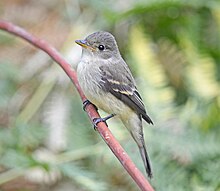 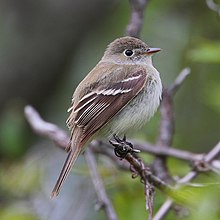 Tyrant flycatchers are passerine birds which occur throughout North and South America. They superficially resemble the Old World flycatchers, but are more robust and have stronger bills. They do not have the sophisticated vocal capabilities of the songbirds. Most, but not all, are rather plain. As the name implies, most are insectivorous.[8]: 215–217
Vireos, shrike-babblers, and erpornisOrder: Passeriformes Family: Vireonidae 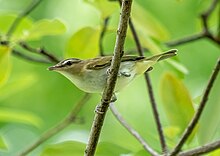 Vireos are a group of small to medium-sized passerine birds mostly restricted to the New World, though few other members of the family are found in Asia. They are typically greenish in colour and resemble wood warblers apart from their heavier bills.[8]: 255–256
ShrikesOrder: Passeriformes Family: Laniidae Shrikes are passerine birds known for their habit of catching other birds and small animals and impaling the uneaten portions of their bodies on thorns. A shrike's beak is hooked, like that of a typical bird of prey.[8]: 270
Crows, jays, and magpiesOrder: Passeriformes Family: Corvidae  The family Corvidae includes crows, ravens, jays, choughs, magpies, treepies, nutcrackers, and ground jays. Corvids are above average in size among the Passeriformes, and some of the larger species show high levels of intelligence.[8]: 271–273
Tits, chickadees, and titmiceOrder: Passeriformes Family: Paridae  Paridae are mainly small stocky woodland species with short stout bills. Some have crests. They are adaptable birds, with a mixed diet including seeds and insects.[8]: 355–356
LarksOrder: Passeriformes Family: Alaudidae Larks are small terrestrial birds with often extravagant songs and display flights. Most larks are fairly dull in appearance. Their food is insects and seeds.[8]: 339–340
SwallowsOrder: Passeriformes Family: Hirundinidae  The family Hirundinidae is adapted to aerial feeding. They have a slender streamlined body, long pointed wings, and a short bill with a wide gape. The feet are adapted to perching rather than walking, and the front toes are partially joined at the base.[8]: 350–351
KingletsOrder: Passeriformes Family: Regulidae  Kinglets are a small family of birds which resemble the titmice. They are very small insectivorous birds. The adults have coloured crowns, giving rise to their name.[8]: 366–367
WaxwingsOrder: Passeriformes Family: Bombycillidae 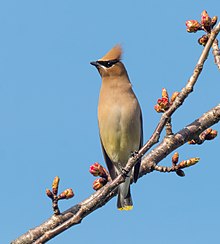 Waxwings are a group of passerine birds with soft silky plumage and unique red tips to some of the wing feathers. In the Bohemian and cedar waxwings, these tips look like sealing wax and give the group its name. These are arboreal birds of northern forests. They live on insects in summer and berries in winter.[8]: 368–370
NuthatchesOrder: Passeriformes Family: Sittidae  Nuthatches are small woodland birds. They have the unusual ability to climb down trees head first, unlike other birds which can only go upwards. Nuthatches have big heads, short tails and powerful bills and feet.[8]: 374–375
TreecreepersOrder: Passeriformes Family: Certhiidae Treecreepers are small woodland birds, brown above and white below. They have thin pointed down-curved bills, which they use to extricate insects from bark. They have stiff tail feathers, like woodpeckers, which they use to support themselves on vertical trees.[8]: 373–374
GnatcatchersOrder: Passeriformes Family: Polioptilidae These dainty birds resemble Old World warblers in their structure and habits, moving restlessly through the foliage seeking insects. The gnatcatchers are mainly soft bluish grey in colour and have the typical insectivore's long sharp bill. Many species have distinctive black head patterns (especially males) and long, regularly cocked, black-and-white tails.[8]: 377–378
WrensOrder: Passeriformes Family: Troglodytidae  Wrens are small and inconspicuous birds, except for their loud songs. They have short wings and thin down-turned bills. Several species often hold their tails upright. All are insectivorous.[8]: 376–377
Mockingbirds and thrashersOrder: Passeriformes Family: Mimidae  The mimids are a family of passerine birds which includes thrashers, mockingbirds, tremblers, and the New World catbirds. These birds are notable for their vocalization, especially their remarkable ability to mimic a wide variety of birds and other sounds heard outdoors. The species tend towards dull greys and browns in their appearance.[8]: 380–381
StarlingsOrder: Passeriformes Family: Sturnidae Starlings and mynas are small to medium-sized Old World passerine birds with strong feet. Their flight is strong and direct and most are very gregarious. Their preferred habitat is fairly open country, and they eat insects and fruit. The plumage of several species is dark with a metallic sheen.[8]: 381–383
DippersOrder: Passeriformes Family: Cinclidae 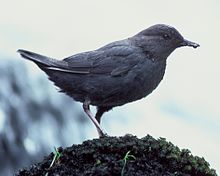 Dippers are a group of perching birds whose habitat includes aquatic environments in the Americas, Europe and Asia. They are named for their bobbing or dipping movements. These birds have adaptations which allows them to submerge and walk on the bottom to feed on insect larvae.[8]: 385–386
Thrushes and alliesOrder: Passeriformes Family: Turdidae  Thrushes are a group of passerine birds that occur mainly but not exclusively in the Old World. They are plump, soft plumaged, small to medium-sized insectivores or sometimes omnivores, often feeding on the ground. Many have attractive songs.[8]: 391–393
Old World flycatchersOrder: Passeriformes Family: Muscicapidae Old World flycatchers are a large family of small passerine birds. These are mainly small arboreal insectivores, many of which, as the name implies, take their prey on the wing.[8]: 387
AccentorsOrder: Passeriformes Family: Prunellidae Accentors are small, fairly drab species superficially similar, but unrelated to, sparrows. However, accentors have thin sharp bills, reflecting their diet of insects in summer, augmented with seeds and berries in winter.[8]: 289–291
Old World sparrowsOrder: Passeriformes Family: Passeridae  Old World sparrows are small passerine birds. In general, sparrows tend to be small plump brownish or greyish birds with short tails and short powerful beaks. Sparrows are seed eaters, but they also consume small insects.[8]: 300–301
Wagtails and pipitsOrder: Passeriformes Family: Motacillidae Motacillidae is a family of small passerine birds with medium to long tails. They include the wagtails, longclaws, and pipits. They are slender ground-feeding insectivores of open country.[8]: 302–303
Finches, euphonias, and alliesOrder: Passeriformes Family: Fringillidae 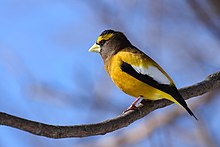  Finches are seed-eating passerine birds, that are small to moderately large and have a strong beak, usually conical and in some species very large. All have twelve tail feathers and nine primaries. These birds have a bouncing flight with alternating bouts of flapping and gliding on closed wings, and most sing well.[8]: 305–306
Longspurs and snow buntingsOrder: Passeriformes Family: Calcariidae 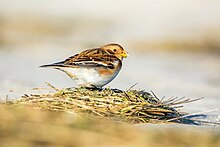 Calcariidae are a group of passerine birds which are mostly endemic to North America. They are primarily found in open fields, where their plumage helps them blend into their surroundings.[20]
New World sparrowsOrder: Passeriformes Family: Passerellidae  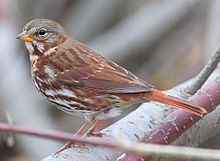 Until 2017, these species were considered part of the family Emberizidae.[21] Most of the species are known as sparrows, but these birds are not closely related to the Old World sparrows which are in the family Passeridae. Many of these have distinctive head patterns.[8]: 314–315
Yellow-breasted chatOrder: Passeriformes Family: Icteriidae This species was historically placed in the wood-warblers (Parulidae) but nonetheless most authorities were unsure if it belonged there. It was placed in its own family in 2017.[22]
Troupials and alliesOrder: Passeriformes Family: Icteridae 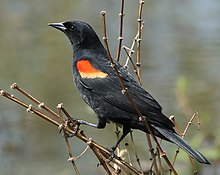 Icterids are a group of small to medium-sized, often colourful passerine birds restricted to the New World and include the grackles, New World blackbirds, and New World orioles. Most species have black as a predominant plumage colour, often enlivened by yellow, orange, or red.[8]: 322
New World warblersOrder: Passeriformes Family: Parulidae  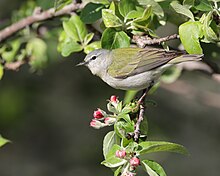 The New world warblers are a group of small often colourful passerine birds restricted to the New World. Most are arboreal, but some are more terrestrial. Most members of this family are insectivores.[8]: 319–320
Cardinals and allies Order: Passeriformes Family: Cardinalidae The cardinals are a family of robust, seed-eating birds with strong bills. They are typically associated with open woodland. The sexes usually have distinct plumages.[8]: 327–328
References
External links
|
Portal di Ensiklopedia Dunia